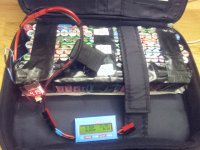A lead acid battery is normally stated as at full charge when the resting voltage is 12.65V (discharged at 11.8V). This is unloaded and with any "surface charge" dissipated. Surface charge is the higher you see when measuring the voltage soon after disconnecting the charger - the battery reads a higher voltage but this doesn't indicate any extra capacity over the 12.65V figure. The surface charge will dissipate with application of a small load or leaving the battery to stand for a day.7
Anyway, onto charging. The battery has a float/standby charge and a fast/full charge voltage. 14.4V is the fast charge and will theoretically get you to 100% of rated capacity, however it causes gassing in the battery and cannot be left in this state for long periods, or the battery will eventually lose its electrolyte.
The float charge voltage is normally given as 13.8V, but for serious applications is derated for higher environmental temperature and might be as low as 13.2V. This will get the battery to within a few percent of full rated capacity but can be left on the charger indefinitely (and indeed this is the best way to store a lead-acid battery).
In summary, charge at 14.4V and disconnect when the charge is complete. Or charge at 13.8V and don't worry about how long the charger is left on the battery. My preference is for the latter unless in a hurry, but fast charging isn't good for lead-acid batteries. I suspect it will come down to what your battery charger happens to do - which I suspect will be 14.4V Best to check because I've seen some cheap-and-nasty automotive chargers go as high as 17V!
It sounds like you used approximately 15% of your battery's capacity on your trip.


